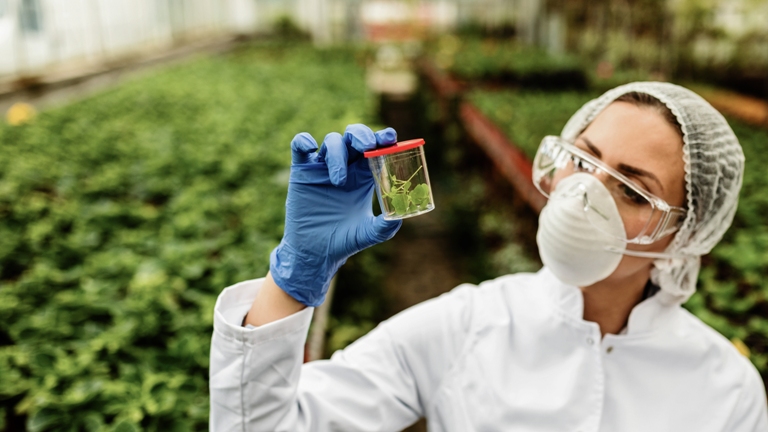Depending on where you live, you’re most likely to have one of six different types of soil: loamy, clay, sandy, silty, chalk, or peat. Knowing which soil type in your yard is essential—and will help you create a lush, self-sustaining farmland, select suitable crops, and troubleshoot any issues. Fortunately, agricultural soil testing can help you figure out what you’re working with.

Different Soil Type:
-
CLAY SOIL:
This soil type contains at least 25% clay. It is particularly good at holding the nutrients due to the microscopic structure of every clay particle. Depending on how the clay soils have been treated, they can either be very compact, drain slowly, and be very heavy to work with—or they might have an excellent porous aggregate structure that permit draining and is a great environment for roots to establish in. The best ways to improve compacted soil are to cultivate them in fall — the freezing temperatures will disintegrate the soil into smaller aggregates—or to promote biological activity by adding the composting plant material.
-
Identifying Clay Soil:
Try the “squeeze test” using a damp dirt sample to confirm you have clay soil. It is recommended to hold it in your hand and squeeze it gently. Sticky soil holds tightly together and can be rolled in clay, noting that ground cover can be critical if you have this soil type. Covering clay soil makes it less vulnerable to the extremes of expansion and contraction. It prevents the sun from baking the clay into hard and impenetrable ‘pottery.
-
SANDY SOIL:
A handful of regions are more likely to have soil made up of sandy substrate. This soil type is quick to drain, warms up fast in the spring, and cools very quickly in the fall. It could be better at holding nutrients or water than other soil types. This means it will drain and dry faster, which can be helpful when growing certain plants.
Plants more sensitive to wet conditions (especially in the winter) perform better in sandy versus clay soil. However, anything that prefers moist conditions will not thrive well in fields with this soil type.
-
Identifying Sandy Soil:
Check your soil to analyze how it fares when you squeeze a clump in your hand. Sandy soil is gritty soil that will not hold together and fall through your fingers. Sandy soil has much less nutrients and doesn’t hold moisture very well. Organic material helps the sand to hold moisture and increases fertility.
-
SILTY SOIL:
Farmers with silty soil have the best of both worlds: fertile, well-draining, and water-retentive soil. It contains mostly intermediate-sized mineral particles that, depending on the other components, can result in a porous or compact soil. This soil type often washes away more easily from rain and water, so it’s best to plant ground-covering perennials in spots where the soil is exposed to avoid erosion.
-
Identifying Silty Soil:
Verify your soil type using Clements’ squeeze test. Very fine soil particles with a soapy and almost water-repelling feel are silty, and you can improve it by adding compost and mulch. Layering the soil also helps prevent the fine dust of silty soil from blowing away.
-
LOAMY SOIL:
This soil type combines the previously mentioned iterations: clay, sand, and silt. It’s usually divided into the sandy or clay loam category, depending on what it contains most. This is very easy to work with and also gives you the perks of both clay and sandy soils.
-
Identifying Loamy Soil:
Loamy soil will also hold its shape slightly but also fall apart easily. In a loamy soil layer, compost and mulch make all the soil more fertile and improve moisture retention.
-
PEAT SOIL:
Most people won’t find peat in their fields; it’s rare and not naturally occurring. Peat is porous and excellent at holding the water and nutrients. Almost all the soil sold in bags meant for indoor growing is peat-based, with very small portions of the mixes being other components. Peat soil is almost very pure organic matter and will decompose and shrink in volume over time.
-
Identifying Peat Soil:
Since this is the usual type of generic soil sold at most nurseries, most plants do well in it. However, some will flourish, like all ericaceous plants. The reason? Peat is much lower in pH as long as lime is not added to it.
-
CHALKY SOIL:
Sometimes described as lime-rich, the chalky soil is an alkaline dirt type variety that can be either light or heavy in structure, based on its components. It’s difficult to lower the pH of alkaline soil, so it won’t be possible to grow ericaceous plants. Chalky soil is defined by a pH more than seven. It can, therefore, consist of different particle sizes, but it usually tends to be connected to clay-rich soil types.
-
Identifying Chalky Soil:
If you have chalky soil, you can do a variation on the squeeze test by adding some vinegar. Chalky soils are chunkier and look like chalk, and they froth when put in a vinegar jar. In highly alkaline, chalky soil, the organic material helps retain moisture and lowers the pH.
How to Improve or Amend Your Soil?
According to our experts, the secret to improving your soil is the same regardless of your type. All soil varieties benefit from the addition of organic components. Excellent soil is 60% inert material (loam, sand, clay, silt, or chalk) and 40% organic for optimal growth. It is recommended that a well-broke-down compost be added frequently. Peat soil is the exception to this as it’s already perfect as is. But take your time to make adjustments.
If you need help in understanding your soil type and also the kind of fertilization you must choose, get in touch with our experts at SoilOptix® today!
